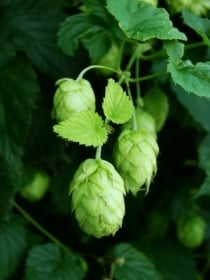This week I take a look at how you can use a blend of hop varieties rather than a single variety to maximize your hop flavor and aroma.
Why Blend Your Hops
While brewers often use different hop varieties for boil hopping, whirlpool hopping and dry hopping, I was not that familiar with the technique of using hop blends until about 5 years ago. I was fortunate enough to be invited to a Craft Beer and Brewing pro-brewer event, where I got to brew with several professional brewers. Many of them used hop blends, consisting of a mix of several varieties of hops, at each stage in the brewing process. This is widely used by many of the top commercial craft breweries.
What are some of the advantages of blending several varieties of hops?
- You can achieve a flavor or aroma blend that might not be achievable using a single variety of hops.
- You can adjust the blend slightly to account for variations in alpha acid from different hop packages.
- You can produce more consistent beer flavor from batch to batch as small variations in any single hop variety have less effect on the overall flavor of the beer.
- You can combine like varieties of hops to achieve a burst of aroma or flavor, or take advantage of certain advanced whirlpool or dry hopping effects.
- You can in some cases use cheaper hops along with more expensive or rare varieties to make great beer at a lower overall cost.
- From a commercial perspective, you minimize your risk from season to season if you can’t get a particular variety in the quantity or quality you like, as you can often substitute one component of the blend without significantly upsetting the flavor balance.
How to Blend Hops
There are a few strategies for choosing the hops to use as well as what portion to use of each. The pros I’ve worked with primarily used hop sensory analysis. You do this by opening several packages of fresh hop varieties and then sampling each primarily using your nose (per this article).
After you have sampled the hops, you next divide out the hops that have the freshest aroma and then start sampling those in pairs. You will likely find a pair that work well together, and you can use those as your base. Then you can add additional hops as desired until you reach the number you are targeting for your blend.
You can, of course, use different blends for bittering, whirlpool and dry hopping, or use the same blend throughout. Quite often the bittering hops blend is chosen differently than the whirlpool/dry hop blends to emphasize flavor over aroma.
Once you have the blend and proportions, brew the beer of course and make adjustments if needed after you sample the finished beer. If you have a disruption in your future hop supply, you can build the base blend again and compare it against a blend made with substitutes to get as close as possible to the original blend.
You can also use a base reference blend to help detect changes from year to year if you have variations in quality such as a hop variety that was not properly harvested, packaged or stored.
Hop blends do have significant advantages, especially for the commercial brewer or home brewer who produces one of their favorite beer styles repeatedly. It partially insulates you from hop supply shocks including price, availability and quality variations.
I hope you enjoyed this week’s article from the BeerSmith Home Brewing Blog. Please subscribe for regular weekly delivery, and don’t hesitate to leave a comment or send this article to a friend.
